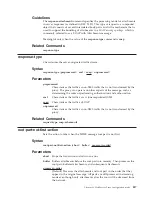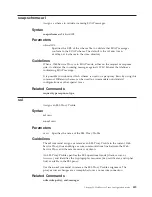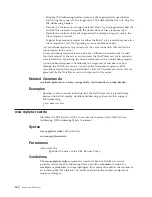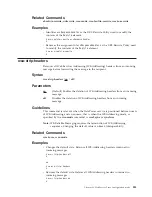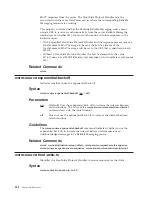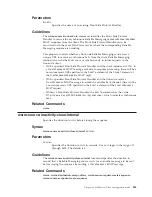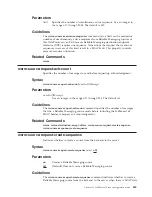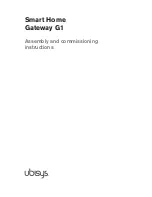
wsa2sync
Specifies that the DataPower service is mediating between hosts that
support WS-Addressing and servers that employ traditional addressing.
wsa2wsa
Specifies that the DataPower service is mediating between hosts and
servers that support WS-Addressing.
Guidelines
The
wsa-mode
command specifies the WS-Addressing support that the DataPower
service provides. The level of support is determined by the WS-Addressing
capabilities of the associated clients and servers. Support for any particular level of
WS-Addressing does not preclude simultaneous support for traditional addressing
formats.
v
When operating in
sync2wsa
mode, the DataPower service, under user control,
can:
– Insert WS-Addressing headers into the traditionally addressed original client
request. The default behavior is to retain the original addressing format.
– Strip the WS-Addressing headers from any server-generated response before
forwarding the response to the original client. The default behavior is to strip
the WS-Addressing headers.
– Process synchronous or asynchronous server responses of either the
ReplyTo
(a standard response to a client request) or
FaultTo
(reporting an error
condition) variety.
A synchronous response is received over the same connection that carried the
client request to the server.
An asynchronous response is received over a different connection that carried
the client request to the server, and requires the DataPower service to maintain
state information associating the received response with an outstanding request.
v
When operating in
wsa2sync
mode, the DataPower service, under user control,
can:
– Insert WS-Addressing headers into the traditionally addressed server
response. The default behavior is to retain the original addressing format.
– Strip the WS-Addressing headers from any client-generated request before
forwarding the request to the target server. The default behavior is to strip the
WS-Addressing headers.
– Rewrite the contents of, or supply default values, for client-generated
ReplyTo
and
FaultTo
elements to specify the destinations of these response types.
– Rewrite the contents of the client-generated
To
element to specify where the
client request is routed.
– Process synchronous or asynchronous server responses of either the
ReplyTo
(a standard response to a client request) or
FaultToA
(reporting an error
condition) variety.
A synchronous response is received over the same connection that carried the
client request to the server.
An asynchronous response is received over a different connection that carried
the client request to the server, and requires the DataPower service to maintain
state information associating the received response with an outstanding request.
v
When operating in
wsa2wsa
mode, the DataPower service under user control,
can:
– Insert WS-Addressing headers into the traditionally addressed server
response. The default behavior is to retain the original addressing format.
Chapter 98. Web Service Proxy configuration mode
831
Summary of Contents for WebSphere XS40
Page 1: ...WebSphere DataPower XML Security Gateway XS40 Command Reference Version 3 7 2 ...
Page 2: ......
Page 3: ...WebSphere DataPower XML Security Gateway XS40 Command Reference Version 3 7 2 ...
Page 44: ...18 Command Reference ...
Page 194: ...168 Command Reference ...
Page 198: ...172 Command Reference ...
Page 206: ...180 Command Reference ...
Page 210: ...184 Command Reference ...
Page 222: ...196 Command Reference ...
Page 232: ...206 Command Reference ...
Page 238: ...212 Command Reference ...
Page 268: ...242 Command Reference ...
Page 272: ...246 Command Reference ...
Page 276: ...250 Command Reference ...
Page 288: ...262 Command Reference ...
Page 292: ...266 Command Reference ...
Page 298: ...272 Command Reference ...
Page 320: ...294 Command Reference ...
Page 322: ...296 Command Reference ...
Page 340: ...314 Command Reference ...
Page 344: ...318 Command Reference ...
Page 352: ...326 Command Reference ...
Page 360: ...334 Command Reference ...
Page 368: ...342 Command Reference ...
Page 376: ...350 Command Reference ...
Page 386: ...360 Command Reference ...
Page 392: ...366 Command Reference ...
Page 396: ...370 Command Reference ...
Page 402: ...376 Command Reference ...
Page 404: ...378 Command Reference ...
Page 408: ...382 Command Reference ...
Page 446: ...420 Command Reference ...
Page 450: ...424 Command Reference ...
Page 456: ...430 Command Reference ...
Page 520: ...494 Command Reference ...
Page 536: ...510 Command Reference ...
Page 550: ...524 Command Reference ...
Page 584: ...558 Command Reference ...
Page 600: ...574 Command Reference ...
Page 605: ... timeout 500 Chapter 63 RADIUS configuration mode 579 ...
Page 606: ...580 Command Reference ...
Page 650: ...624 Command Reference ...
Page 668: ...642 Command Reference ...
Page 704: ...678 Command Reference ...
Page 714: ...688 Command Reference ...
Page 726: ...700 Command Reference ...
Page 734: ...708 Command Reference ...
Page 752: ...726 Command Reference ...
Page 756: ...730 Command Reference ...
Page 804: ...778 Command Reference ...
Page 880: ...854 Command Reference ...
Page 892: ...866 Command Reference ...
Page 912: ...886 Command Reference ...
Page 918: ...892 Command Reference ...
Page 940: ...914 Command Reference ...
Page 946: ...920 Command Reference ...
Page 974: ...948 Command Reference ...
Page 1004: ...978 Command Reference ...
Page 1030: ...1004 Command Reference ...
Page 1032: ...1006 Command Reference ...
Page 1065: ......
Page 1066: ... Printed in USA ...

